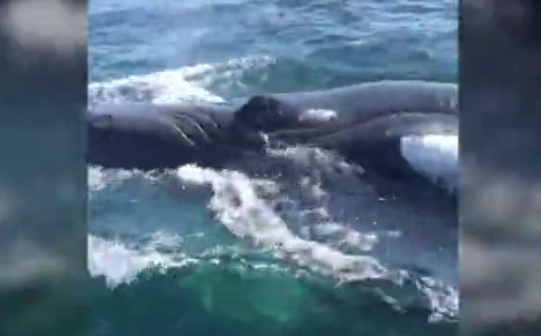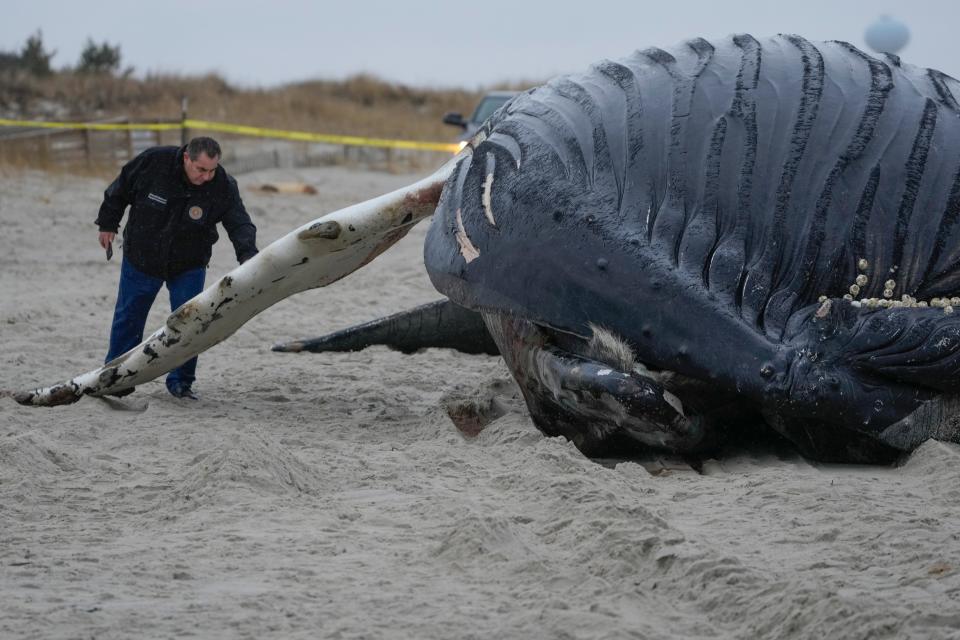More hungry whales are flocking to ship-infested waters. It's a tragic vicious cycle near NYC.
When an uptick in whale deaths off the New York and New Jersey coasts made headlines over the winter, longtime whale researchers in the area weren’t surprised.
For more than a decade, they've seen whale sightings increase in the New York Bight, the wedge of ocean between the tips of the two states.
Humpback whales appear in these waters more often and sometimes in surprising numbers, chasing abundant, silvery bait fish. Endangered North Atlantic right whales, minke whales and fin whales also are seen.
In a development that would have been surprising a decade ago, "you can go whale watching from Brooklyn,” said Howard Rosenbaum, a native New Yorker and director of the Wildlife Conservation Society’s Ocean Giants Program.
But the influx of whales puts the animals at greater risk of human interaction, their single biggest threat.
Scientists say it’s well-documented threats – vessel collisions, fishing gear and climate change – that bear much of the responsibility for an increase in East Coast whale deaths dating back to 2017.
Perhaps nowhere is that threat greater than in the waters of the New York Bight. Some of the world’s biggest ships – laden with cargo for U.S. consumers – pass through these waters on their way to one of the world’s busiest ports, the Port of New York and New Jersey.
Read more: Latest climate change news from USA TODAY
Earth Day: Scientists tell us what 2050 could be like. Their answers might surprise you.
Whale sightings off New York and New Jersey shores
Since Paul Sieswerda, retired curator for the New York Aquarium, founded Gotham Whale in 2009, staff and volunteers have reported exponential increases in whale sightings. They’ve cataloged more than 300 individual humpbacks, as well as fin, minke and right whales.
Rosenbaum, who has studied marine life in every ocean, was as surprised as anyone when he first began hearing about the increase in whales seen in the nearshore waters.
It’s “a truly amazing wildlife spectacle” to see charismatic, iconic whales lunge feed or breach in the water with the New York skyline in the background, he said.
When he started taking boats out for summer whale surveys, local fishing boat captains were skeptical. Today, Rosenbaum said, they recognize whales by species and know where they are and what they're doing.
Why are the whales in the New York Bight?
Researchers can't fully explain why the whales are there. A variety of circumstances likely contribute, including greater aggregations of fish, warmer water driven by climate change, water quality improvements, a very slow increase in the humpback whale population and even just the whims of individual whales.
How does climate change affect you? Subscribe to the weekly Climate Point newsletter
Previously, researchers assumed humpbacks and other whales passed through during migration. They knew the humpbacks moved through but didn't think they stayed. They knew, for example, that humpbacks migrate from the Northeast to the Caribbean in the winter. But through acoustic surveys, Rosenbaum said they’ve detected some humpbacks in the winter in the waters off New Jersey and New York.
Although whales of all ages and species are seen in the region outside traditional migration season, research shows it has become a popular feeding ground for young humpbacks in the spring, summer and fall.
A lot of the whales moved into the area from the Gulf of Maine feeding population, said Danielle Brown, director of research for Gotham Whale and a doctoral candidate at Rutgers University in New Jersey. Many are juveniles or young adults, some as young as 1-2 years old, she said.

"The first few years of a humpback whale's life are when they are most vulnerable. They are learning how to feed away from their mothers and how to interact with their environment," she said. "These inexperienced juveniles are feeding alongside some of the greatest dangers to whales."
The young whales sometimes feed at the surface and appear to be oblivious to boats, which puts them in greater danger. And, at roughly 25-35 feet long, the younger whales can be harder for boat pilots to see.
Studies investigating a spate of humpback whale deaths on the East Coast in the 1990s concluded the deaths were in part due to juvenile whales that were in harm's way.
Graphic: Whale deaths off New Jersey, across East Coast are causing alarm. Here's a detailed look
Dying whales: Advocates say whale deaths exploited in disinformation campaign
What studies show about fish and whales in the New York Bight
Wildlife Conservation Society studies show the whales are feeding on flourishing aggregations of two kinds of small, silvery fish: sand lance and Atlantic menhaden.
Scientists hope to learn more about the role of the fish in the whales' activity.
Within 6 miles of shore, whales foraging alone and in groups are seen in areas where menhaden are prolific, said Carissa King-Nolan, assistant marine conservation scientist with the wildlife society.
Farther offshore, mixed groups of marine life chase the eel-like and easy-to-swallow sand lance, King-Nolan said. “Humpback whales, fin whales, minke whales, common dolphins and even seabirds will feed … on these huge balls of sand lance,” she said.
Over the winter, lots of menhaden were seen in Raritan Bay, an area of the Bight close to the harbor, Sieswerda said. Ocean temperatures about 10 degrees warmer than normal may have attracted the fish and kept the whales in the area longer.
Why are the whales dying?
The National Oceanic Atmospheric Administration and its collaborators have been investigating increases in the deaths of humpbacks, right whales and minke whales along the East Coast since 2016.

Deaths among the three large whale species have fluctuated from year to year but averaged 53 animals a year along the East Coast between 2017 and 2022.
Since Dec. 1, NOAA has reported 33 large whale deaths between Florida and Maine. Twenty-two of the deaths were humpbacks and at least 11 of those were off New York and New Jersey coasts. The others include:
Four minke whales.
Three sperm whales.
Two right whales.
One sei whale.
One fin whale.
Graphic: Whale deaths off New Jersey, across East Coast are causing alarm. Here's a detailed look
Scientists haven't yet concluded what's killing the whales. When a dead whale washes up on a beach, it's often too decomposed to perform a necropsy. But in cases where a cause of death can be determined, most are the result of either a ship strike or fishing gear entanglement. At least six whale deaths since December were suspected vessel strikes.
In the New York Bight, more research is needed to understand where the whales are traveling and why, and urgent action is needed to monitor and enforce speed limits for larger vessels, Rosenbaum said.
"It's beyond high time" to do more to protect the whales, he said.
This article originally appeared on USA TODAY: Why so many whale sightings, deaths near New York and New Jersey?

